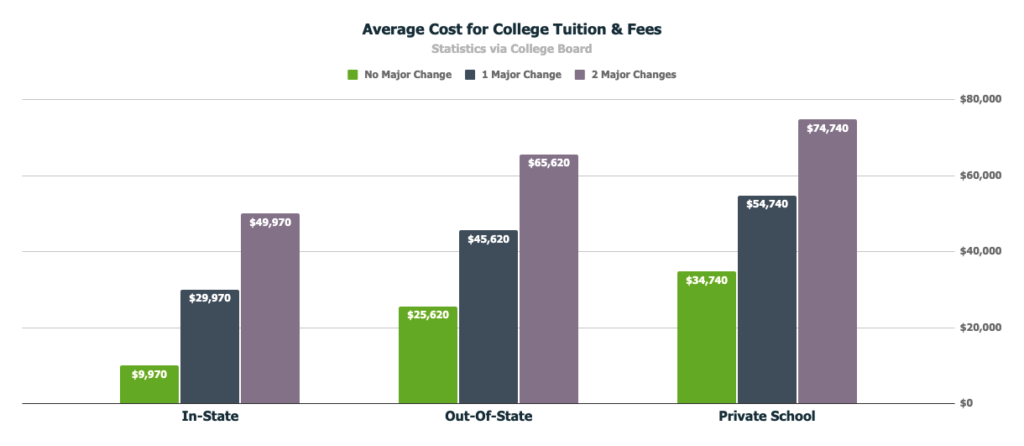It’s no secret that college is expensive. But it can be even more expensive if your student goes in without a plan and ends up changing their major. In this blog, I’ll explain exactly how expensive this lack of planning can be, and specifically how to avoid the cost of changing college majors in 2 steps. But first…
… Has your student thought about one of the most crucial yet overlooked questions to answer before they enter college: ”What do I plan to do with my degree after college graduation?”
A vital part of the college planning process is major and career exploration. In other words, figuring out how a student’s chosen major will lead to their future career.
I worked as an academic advisor at The University of Tulsa for several years and observed that many students came to college with little to no idea of what they wanted to accomplish with their education. Even students who had specific majors, like finance, didn’t really understand what career that would translate to after graduation.
When students realize that their current path will not actually lead them to a career aligned with their interests or strengths, they change their major. In fact, according to the National Center for Education Statistics, 30% of college students will change their major at least once within 3 years of enrollment.
Unfortunately, something as simple as changing majors during college can come with many costs.
The Cost of Changing College Majors
There are at least three ways that changing college majors can be a costly path for your student.
The Financial Cost
Changing majors after starting college can take an enormous toll on your finances. A toll of approximately $20,000 per major change, according to one report.
The College Board reports the average cost for tuition and fees is now up to $9,970 for in-state students, $25,620 for out-of-state students, and $34,740 for private school students. Here is a way to imagine the impact of going into school without a plan.
After two major changes, your student’s in-state tuition costs can end up being over $15,000 greater than that of a typical private school – not to mention any extra expenses for room and board.

If your teenager took AP, IB, or dual enrollment courses in high school with the hopes of saving money through early graduation, this might be in jeopardy too. Often, students who change their major often incur greater tuition costs because they end up graduating later than planned.
The Cost to Well-Being
And the costs aren’t just financial – your teen’s mental and social wellbeing can take a toll too.
Many families think about college as a time for self-exploration. But students shouldn’t enter higher education “blind” without a sense of who they are – what strengths and stressors they have.
For example, if your teen is very interested in a particular major, it might not be practical for them to pursue it if the nature of that discipline is mismatched with their strengths and stressors. Instead of flourishing, your student might flounder in the wrong major – leaving them in a place of stress rather than success.
In addition, changing majors often means your student will need to enroll in extra semesters to complete their degree. Because of this, your student might feel a great deal of social isolation.
The Cost to Freedom and Creativity
Changing college majors also limits the amount of freedom and creativity that your student can experience during their college career.
If your teenager wants to graduate on time after making their major change, they’ll have less flexibility in what courses they can take. This means, your teen will be restricted in any of the following:
- Enrolling in elective courses
- Pursuing a minor
- Studying abroad
- Graduating early
So, how can families avoid financial expenses, negative impacts on their student’s well-being, and limits to their freedom and creativity?
By planning ahead.
Avoid The Cost of Changing College Majors in 2 Steps
Here are 2 steps I recommend all of my students take before college to avoid the cost of changing majors during college.
1. Spark Interest Through Hands-On Experience
The first step is to introduce students to experiences that help identify their abilities and spark career interests. This can be done in high school through things like…
- Job shadowing
- Internships
- Vocational summer programs
These allow students to see subjects applied in real-world work environments. Such encounters help them narrow their potential career fields by revealing things they do or don’t enjoy.
For example, I worked with an 11th grader who wanted to pursue a career as a medical researcher. After shadowing a researcher in a lab for three weeks last summer, she decided she preferred to major in public health and pursue a career in this field. As a bonus, the experience also provided her with an excellent story for her college application essay.
2. Chart a Realistic Course To Actualize Their Dreams
The second step is equally important. Many students foster dreams for their futures but are uninformed about what it will take to get there.
Our clients take a detailed Birkman Interest and Behavior Assessment. The Birkman Assessment, developed 65 years ago, is widely used today by Fortune 500 companies to do the following:
- Identify leadership
- Create teams
- Develop career tracks for employees
The assessment results put our clients in a better position to make educated major and career decisions.
It is important to counsel students to understand what education and skills they need to actualize their dreams, and then help them chart a course to make it a reality.
Thinking about the future can be confusing or overwhelming for many young people. Empowering your student starts by asking fundamental questions like:
- What do you like to study?
- What kind of a career do you want?
- What’s the path for getting there?
My role as an independent college and career counselor with Bright Futures Consulting is to provide information resources to help students answer these big questions for themselves.
When it comes to preparing our students for college and careers, we should work together to ensure they are making informed decisions. Having a well-researched college strategy won’t completely eliminate young people from changing majors during college, but it is an important shift from a position of limited planning to one of making informed investments.
If your student is looking for guidance on how to approach these 2 steps to avoid the costs of changing their college major later down the road, schedule a complimentary consultation with me here.
– Written by Dr. Avonna Swartz
[elementor-template id=”5290″]
